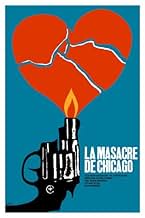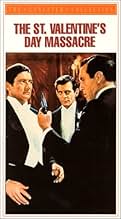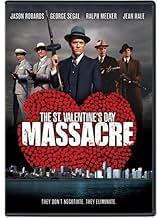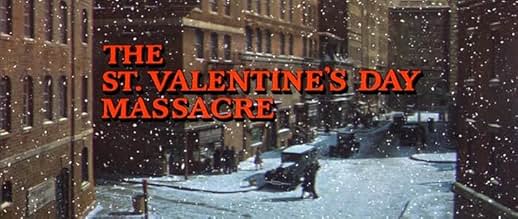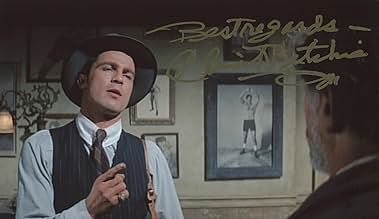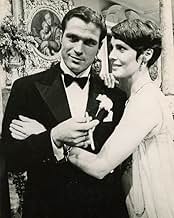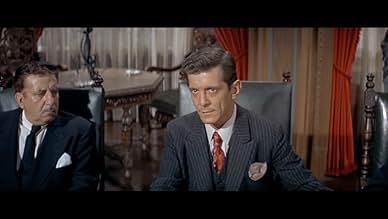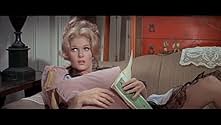NOTE IMDb
6,6/10
5,1 k
MA NOTE
Une surprise de la Saint-Valentin, d'Al Capone pour le gang rival dans le Chicago de 1929.Une surprise de la Saint-Valentin, d'Al Capone pour le gang rival dans le Chicago de 1929.Une surprise de la Saint-Valentin, d'Al Capone pour le gang rival dans le Chicago de 1929.
Joe Turkel
- Jake 'Greasy Thumb' Guzik
- (as Joseph Turkel)
Avis à la une
This is a very entertaining account of the famous rub-out in 1929 Chicago. Jason Robards is a decent Al Capone, and thankfully, doesn't try for an Italian accent. He also wields a mean baseball bat, thus having Capone's malice down but not his mass. Ralph Meeker plays Bugs Moran, leader of the rival Chicago gang. The cast is loaded with familiar faces and future stars, and it seems like somebody gets bumped off every ten minutes. Harold J. Stone plays Frank "The Enforcer" Nitti and almost, but not quite, convinces me he could be Italian. George Segal has a riotous brawling scene with Jean Hale after he finds out she spent three grand on a fur coat. Joan Shawlee has a bit as a "streetwalking entrepreneur," as we call it now. Jack Nicholson has one line, which he grunts out in a hoarse voice pre-Don Corleone. And you may even feel sorry for Bruce Dern in this film.
The movie was directed by Roger Corman, and features some of his stock players, including Dick Miller as one of the hit men. Paul Frees supplies the narration, giving this a semi-documentary feel. But he is no Walter Winchell. Definitely worth a look.
The movie was directed by Roger Corman, and features some of his stock players, including Dick Miller as one of the hit men. Paul Frees supplies the narration, giving this a semi-documentary feel. But he is no Walter Winchell. Definitely worth a look.
It took me a while before I really appreciated this film. Despite its flaws, this is probably the most serious, accurate, and restrained treatment on the subject you're ever going to get without watching a straight-out documentary. What you have is sort of a "docudrama" on the infamous St. Valentine's Massacre, and the events leading up to it.
Not that the film ST. VALENTINE'S DAY MASSACRE takes itself too seriously. It doesn't, but all of the over-the-top acting merely enhances the product. There are still some inaccuracies but the story adheres so closely to the actual facts that these discrepancies are easily forgiven. The violence shown might have been considered sensational in 1967, and this was most probably the intent, but it's pretty tame by today's standards. And if it falls short of being a great film, it's a near miss rather than one by a mile.
In this dramatization of the final showdown between the South Side and North Side gangs for control of Chicago's underworld in 1929, Jason Robards takes center stage as Al Capone. He might have been much older and looked nothing like the real Capone but then so what. As they say, you want an interpretation and not an impersonation. His histrionic performance, with all of its eye-rolling and exaggeration, strikes just the right note and does its part to help keep things moving throughout. This was an actor who knew what he was doing, and exactly how he should play it in this instance.
But it takes a while for Capone to show up, finally seen casually arriving in a limousine on his way to a board meeting with his underlings. The first hood to show up on screen is played (some could say overplayed) by George Segal as Pete Gusenberg, a member of the rival gang, who proceeds to intimidate a bar-owner. Actually, Segal gives a rather convincing performance as a very smug, arrogant thug who enjoys pushing people around, and acting like he's one bad dude, with guns and a gang to back him up.
A very effective technique employed throughout the film, provided by narrator Paul Frees, is the frequent voiceover commentary on various characters. Information is given, such as that the individual was born on this or that date, at whatever place, something about his background, and his place in the particular gang, etc. (often including his time of death as well). Not only does this provide an easily-understood guide for who's who, but it helps to get the viewer involved with these characters however unsympathetic or unsavory they might be.
In brief but well-played roles, on the Capone side, there's Paul Richards as Charlie Fischetti, Joseph Turkel as Jake Guzik, and Harold Stone as Frank Nitti, with a more conspicuous role played by Clint Richie as Jack McGurn, who gets put in charge of organizing the title massacre. That particularly bloody episode was designed to rid Capone of his archenemy and chief rival, George "Bugs" Moran, capably played by tough-talking Ralph Meeker. Moran was the head of the North Side gang, and in flashback scenes we're shown what befell Moran's two predecessors, Dion O'Bannion (played by John Agar) and Hymie Weiss (played by Reed Hadley).
The rest of the cast is made up of many fine actors, some familiar and others less so. Among the unlucky seven who have an appointment up against a certain garage wall, besides Segal's Pete Gusenberg, included are David Canary as Pete's brother Frank, Kurt Krueger as Moran's top lieutenant, Milton Frome as the gang's accountant, Joseph Campanella as a low-level employee, Bruce Dern as a mechanic, and Mickey Deems as a hanger-on. Not to be overlooked is the always excellent Frank Silvera as Nick Sorello, a not completely innocent pawn used in trying to set up Moran.
Almost every actor with a speaking role gets at least one good scene and a chance to shine, from the major actors right on down to several of the minor supporting players. An attempt is made to show some of the camaraderie and interaction among the members of each gang. The careful planning of the "hit" is laid out, including an amusing scene where two gunmen, posing as musicians, are renting a room from a wary landlady.
Such details add to the plot and the characterizations, with keen attention being paid to recreating a 1920s atmosphere, and don't forget all of the various gunplay and assorted mayhem along the way, leading up to the fateful massacre. They even throw in a completely superfluous fight between Gusenberg (Segal) and his girlfriend over a fur coat. Since it's only a brief rest from the action, and we get to rest our eyes on Jean Hale, then what's the harm. Enjoy this trip back in time to gangland Chicago.
Not that the film ST. VALENTINE'S DAY MASSACRE takes itself too seriously. It doesn't, but all of the over-the-top acting merely enhances the product. There are still some inaccuracies but the story adheres so closely to the actual facts that these discrepancies are easily forgiven. The violence shown might have been considered sensational in 1967, and this was most probably the intent, but it's pretty tame by today's standards. And if it falls short of being a great film, it's a near miss rather than one by a mile.
In this dramatization of the final showdown between the South Side and North Side gangs for control of Chicago's underworld in 1929, Jason Robards takes center stage as Al Capone. He might have been much older and looked nothing like the real Capone but then so what. As they say, you want an interpretation and not an impersonation. His histrionic performance, with all of its eye-rolling and exaggeration, strikes just the right note and does its part to help keep things moving throughout. This was an actor who knew what he was doing, and exactly how he should play it in this instance.
But it takes a while for Capone to show up, finally seen casually arriving in a limousine on his way to a board meeting with his underlings. The first hood to show up on screen is played (some could say overplayed) by George Segal as Pete Gusenberg, a member of the rival gang, who proceeds to intimidate a bar-owner. Actually, Segal gives a rather convincing performance as a very smug, arrogant thug who enjoys pushing people around, and acting like he's one bad dude, with guns and a gang to back him up.
A very effective technique employed throughout the film, provided by narrator Paul Frees, is the frequent voiceover commentary on various characters. Information is given, such as that the individual was born on this or that date, at whatever place, something about his background, and his place in the particular gang, etc. (often including his time of death as well). Not only does this provide an easily-understood guide for who's who, but it helps to get the viewer involved with these characters however unsympathetic or unsavory they might be.
In brief but well-played roles, on the Capone side, there's Paul Richards as Charlie Fischetti, Joseph Turkel as Jake Guzik, and Harold Stone as Frank Nitti, with a more conspicuous role played by Clint Richie as Jack McGurn, who gets put in charge of organizing the title massacre. That particularly bloody episode was designed to rid Capone of his archenemy and chief rival, George "Bugs" Moran, capably played by tough-talking Ralph Meeker. Moran was the head of the North Side gang, and in flashback scenes we're shown what befell Moran's two predecessors, Dion O'Bannion (played by John Agar) and Hymie Weiss (played by Reed Hadley).
The rest of the cast is made up of many fine actors, some familiar and others less so. Among the unlucky seven who have an appointment up against a certain garage wall, besides Segal's Pete Gusenberg, included are David Canary as Pete's brother Frank, Kurt Krueger as Moran's top lieutenant, Milton Frome as the gang's accountant, Joseph Campanella as a low-level employee, Bruce Dern as a mechanic, and Mickey Deems as a hanger-on. Not to be overlooked is the always excellent Frank Silvera as Nick Sorello, a not completely innocent pawn used in trying to set up Moran.
Almost every actor with a speaking role gets at least one good scene and a chance to shine, from the major actors right on down to several of the minor supporting players. An attempt is made to show some of the camaraderie and interaction among the members of each gang. The careful planning of the "hit" is laid out, including an amusing scene where two gunmen, posing as musicians, are renting a room from a wary landlady.
Such details add to the plot and the characterizations, with keen attention being paid to recreating a 1920s atmosphere, and don't forget all of the various gunplay and assorted mayhem along the way, leading up to the fateful massacre. They even throw in a completely superfluous fight between Gusenberg (Segal) and his girlfriend over a fur coat. Since it's only a brief rest from the action, and we get to rest our eyes on Jean Hale, then what's the harm. Enjoy this trip back in time to gangland Chicago.
8qrt7
Taking a step back from the intellectual surmising involving Godfather, Goodfellas et al., I thought this was an enjoyable film, 'a live action cartoon' as it was put.
Yep, sure it was a tad formulaic with characters going about their predetermined business and the armchair historians knew the conclusion of the film before it happened. I accept this as valid criticism, but I would stress more that it is supposed to be a quasi-documentary, with the solemn narrator venting sparse mechanical facts about each character and their relevance to the bigger picture as they were introduced. The film itself wasn't trying (I felt) to make a big artistic or intellectual statement, just an enjoyable and disposable piece of cinema. I think that it would be worse if it had been trying top make a 'big point' but fell on its arse, which a number of mobster-related films are guilty of.
As an enjoyable 'get on and enjoy the ride' movie I think it succeeded very well. Having only a basic knowledge of prohibition gangsterland, I found it quite gripping and that the documentary style enhance my enjoyment of an otherwise complex background. The set was also very well done, though Capone was miscast.
I would recommend this to most, unless they are Godfather fans!
8/10
Yep, sure it was a tad formulaic with characters going about their predetermined business and the armchair historians knew the conclusion of the film before it happened. I accept this as valid criticism, but I would stress more that it is supposed to be a quasi-documentary, with the solemn narrator venting sparse mechanical facts about each character and their relevance to the bigger picture as they were introduced. The film itself wasn't trying (I felt) to make a big artistic or intellectual statement, just an enjoyable and disposable piece of cinema. I think that it would be worse if it had been trying top make a 'big point' but fell on its arse, which a number of mobster-related films are guilty of.
As an enjoyable 'get on and enjoy the ride' movie I think it succeeded very well. Having only a basic knowledge of prohibition gangsterland, I found it quite gripping and that the documentary style enhance my enjoyment of an otherwise complex background. The set was also very well done, though Capone was miscast.
I would recommend this to most, unless they are Godfather fans!
8/10
If you love movies, this Roger Corman entry into the gangster genre is a revelation. The story is told in a series of loosely connected episodes that supposedly document real circumstances leading up to the St. Valentine's Day Massacre. A narrator tells us what we need to know for each scene, moving the action forward with an astonishing speed and clarity. Corman stamps the Docudrama style with this convention, and it really works; the immediate story is constantly informed by the narrator's voice-of-god telling of characters' past, present, and future circumstances. Even though the visual dimension of the film never escapes its studio locations, Corman's staging and his work with the actors gives it a sense of urgency. Corman has never really been talked about as an actor's director, but here he apparently had the time, the script, and I assume the inclination to let the players rip through the ceiling. The performances are all terrific. Jason Robards (looking nothing like Al Capone!) has an insane, maniacal smile that is often more unsettling than his violent rages. The camera seems to follow him around without the interruption of a cut; his mood swings keep his men in line and the viewer disarmed. True, Robards carries on, but it seems appropriate for the movie. George Segal has two great scenes that seem to play out without interruption. The one with Barbara Hale is a doozy. In fact, all through the film, Corman showcases characters in often ironic situations creating a tapestry of collective behavior that gives the film an amazing sense of vitality. Its the odd, subjective character detail that builds this story; we get involved not in the melodramatics of the story, per se, but rather in the lives of those individuals that come together who create the story.
In a very real way, Corman's approach pre-figures and creates the template for Coppola's internal view of the Mafia in the GODFATHER movies. It lacks the scope of Coppola's saga, for sure. But it sets the precedent. Corman was a terrific director. This movie was the only one he did for a major studio, 20th Century Fox. As a director, a major studio suited Corman, the artist. But as a producer, Corman has written about his distain for studio waste and book keeping. So for the next few years, before giving up directing altogether, Corman continued to work on his own under his safe and financially responsible American International umbrella. If you love movies, this is one you will cherish. Please give it a look. It a rich, satisfying, and disarmingly complex little gangster movie; terrifically entertaining.
In a very real way, Corman's approach pre-figures and creates the template for Coppola's internal view of the Mafia in the GODFATHER movies. It lacks the scope of Coppola's saga, for sure. But it sets the precedent. Corman was a terrific director. This movie was the only one he did for a major studio, 20th Century Fox. As a director, a major studio suited Corman, the artist. But as a producer, Corman has written about his distain for studio waste and book keeping. So for the next few years, before giving up directing altogether, Corman continued to work on his own under his safe and financially responsible American International umbrella. If you love movies, this is one you will cherish. Please give it a look. It a rich, satisfying, and disarmingly complex little gangster movie; terrifically entertaining.
"The Saint Valentine's Day Massacre" is a very good gangster movie, released five years before the all-time great "The Godfather". It's pretty accurate in its chronology, according to the books and documentaries I've seen about the incident, only a couple of dramatic licenses taken. The film unfolds like a documentary, showing the dynamics of the rival gangs and their blood feud. Opening with the killers leaving the garage and then the neighbors discovery of the massacre, it proceeds to detail the buildup to the crime. The victims are introduced, along with the killers and planners. Lots of good actors are in this, veterans of both the big and little screen. Jason Robards has been slammed for his over-the-top portrayal of Al Capone, but everything I've seen about Scarface shows that he was over-the-top himself. George Segal is especially good as a Moran gang member, Peter Gusenberg. Ralph Meeker is a tough , barrel chested Bugs Moran. Both gangs are filled with familiar, competent actors. Jean Hale has a nicely done cameo as a classic "gun Moll", Myrtle, Pete's squeeze. Even Jack Nicholson shows up as a Tommy gunner! The climactic massacre is chillingly accurate using forensic evidence to show how the victims fell and their final positions. All-in-all, a really good movie and record of one of the most famous and shocking events in American criminal history. 8 of 10.
Le saviez-vous
- AnecdotesFor the massacre scene in the garage, the actors playing the slain gangsters were shown photos and directed as how to fall so their positions were identical to the real photos of the massacre. Two actors bumped together on the way down. After studying photographs they realized they had fallen and collided in the exact way the slain gangsters had fallen and had landed in the correct positions.
- Citations
Reporter: Y'know some are sayin' that it really was the cops who shot those men.
Bugs Moran: You must be new to this town, mister. Only Al Capone kills like that.
- ConnexionsEdited into Capone (1975)
Meilleurs choix
Connectez-vous pour évaluer et suivre la liste de favoris afin de recevoir des recommandations personnalisées
- How long is The St. Valentine's Day Massacre?Alimenté par Alexa
Détails
- Date de sortie
- Pays d’origine
- Langues
- Aussi connu sous le nom de
- Le Massacre de la Saint-Valentin
- Lieux de tournage
- Desilu Studios - 9336 W. Washington Blvd., Culver City, Californie, États-Unis(street scenes, garage - exteriors)
- Société de production
- Voir plus de crédits d'entreprise sur IMDbPro
Box-office
- Budget
- 1 000 000 $US (estimé)
- Durée1 heure 40 minutes
- Couleur
- Rapport de forme
- 2.35 : 1
Contribuer à cette page
Suggérer une modification ou ajouter du contenu manquant


